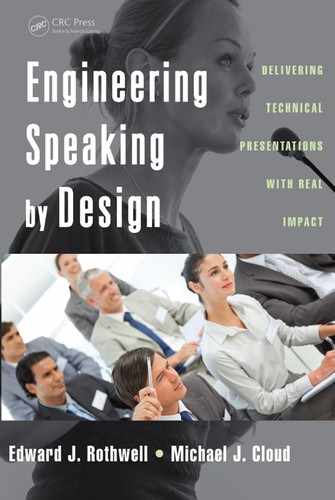Book Description
From the Authors of Engineering Writing by Design: Creating Formal Documents of Lasting Value
Engineering presentations are often a topic of frustration. Engineers complain that they don't enjoy public speaking, and that they don't know how to address audiences with varying levels of technical knowledge. Their colleagues complain about the state of information transfer in the profession. Non-engineers complain that engineers are boring and talk over everybody’s heads.
Although many public speaking books exist, most concentrate on surface issues, failing to distinguish the formal oral technical presentation from general public speaking.
Engineering Speaking by Design: Delivering Technical Presentations with Real Impact targets the formal oral technical presentation skills needed to succeed in modern engineering. Providing clear and concise instruction supported by illustrative examples, the book explains how to avoid logical fallacies (both formal and informal), use physical reasoning to catch mistakes in claims, master the essentials of presentation style, conquer the elements of mathematical exposition, and forge a connection with the audience. Each chapter ends with a convenient checklist, bulleted summary, and set of exercises. A solutions manual is available with qualifying course adoption.
Yet the book’s most unique feature is its conceptual organization around the engineering design process. This is the process taught in most engineering survey courses: understand the problem, collect relevant information, generate alternative solutions, choose a preferred solution, refine the chosen solution, and so on. Since virtually all engineers learn and practice this process, it is so familiar that it can be applied seamlessly to formal oral technical presentations.
Thus, Engineering Speaking by Design: Delivering Technical Presentations with Real Impact is inherently valuable in that it shows engineers how to leverage what they already know. The book’s mantra is: if you can think like an engineer, you can speak like an engineer.
Table of Contents
- Cover
- Half Title
- Title Page
- Copyright Page
- Dedication
- Table of Contents
- Preface
- Authors
- 1 Becoming a Presenter
- 2 Engineering a Presentation
- 3 Designing Your Presentation
- 4 Building Your Presentation
- 5 Optimizing Your Presentation
- 6 Showtime: Delivering Your Presentation
- 7 Success! (What Now?)
- Further Reading
- Appendix: Presentation Checklist
- Index
